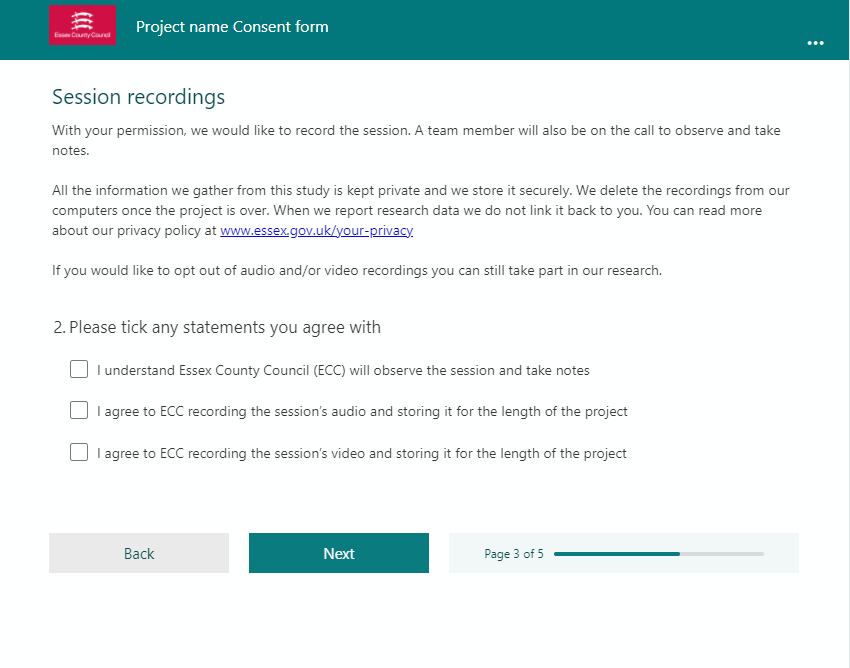Today we’re sharing the first of our new user research templates and guides. We designed these for teams working within the council, and they can easily be adapted for teams working in other councils. You’ll find these on GitHub. Download them, make them your own, and let us know if we can make them even better.

Why did we create these templates?
We couldn’t find our existing templates
Our existing templates were saved across multiple repositories and personal drives. As researchers joined and left the team, not everyone in the team knew templates existed or where they were saved.
The way we carried out research across the team was inconsistent
Researchers had different ways of doing the same thing. Researchers were using different documents with different language and functionality. The participant experience was inconsistent.
We were working harder, instead of smarter
Researchers were creating new documents when templates already existed.
We wanted to share good practice in user research with other colleagues in the council.
For small scale, low-budget research we wanted to provide support for teams to run their own research. Our newly created templates and guide library support this.
How did we get started?
First, we tried to find our existing templates and move them to one centralised place. Next, we gave some thought to what else we might need. We then voted on which templates we should look at first. From this process we decided to start with:
- the tone of voice across all our materials
- our consent form
- our participant information sheet.
Establishing our tone of voice
Before we looked at our templates we reflected on our tone of voice. We knew the primary users for our materials would be participants and colleagues. So, we brainstormed what tone of voice we wanted for our materials. Words we came up with included: fair, transparent, clear, trustworthy, approachable, and inviting.
Revising our existing consent form and participant information sheet
Our consent form and participant information sheet were the first documents we looked at. We had several versions in use at the same time. Some of us were using PDFs for consent forms and for remote studies we wanted something that participants didn’t need to print and scan.
Some things we questioned to begin with were:
- what platforms could we use for an online form?
- what information must be in the consent form and information sheet?
- how long do we need to retain data?
- what were other organisations doing?
How we did this
Microsoft Forms is a tool we readily have access to and we can use it to share a form with both external and internal research participants. Using this to collect participant consent, we can download the results in a spreadsheet and keep this with any session recordings. Microsoft Forms is also accessible for participants who rely on screen readers and/or keyboards to navigate.
We used the guidance from GOV.UK Service Manual as a checklist to make sure nothing important was missing from our consent form and information sheet.
We spoke with our information governance department to get expert advice on data retention.
We got in touch with user researchers at Hackney Council, who shared their excellent research guides with us.
Back to our tone of voice
Our consent form and information sheet went through several iterations as we collected feedback from our team of user researchers and content designers. With the help of the Hemingway App we revised our content with simpler, more approachable language. We also made use of some research undertaken at Hackney Council, around what language participants best understand within consent forms. We re-designed our consent form, letting participants know that their participation is voluntary up front, to better reassure them. And we broke down the consent to give participants more options and the ability to control their consent while still taking part in research. For example, under recording a session, where participants previously consented to a notetaker and audio and video recordings, participants can now choose to have only a notetaker, a notetaker and audio recordings, or a notetaker and audio and video recordings.
New templates and guides
Building on similar guides produced by Hackney Council we also created two completely new guides:
- observing and notetaking
- managing user research data.
We’d also like to create more templates and guides in the future. Materials we are hoping to create soon include:
- research ethics and safeguarding guides
- a bank of screener questions.
You’ll find all our templates and guides in our GitHub repository.
The documents are still a work in progress and we hope to add more templates and guides.
We’d love to hear from you. Do let us know how we can make these templates and guides better. Or drop the user research team a line at stux@essex.gov.uk.
Leave a comment